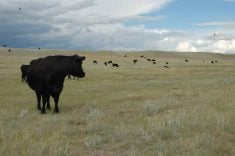BOISSEVAIN, Man. – When Boissevain’s veterinarian of 42 years announced his retirement, mayor Ed Anderson started to worry.
Boissevain is prime beef cattle country, hog production is growing and most of the province’s pregnant mare’s urine farms, which collect urine used in estrogen replacement therapy, are located near the southwestern Manitoba town.
The retiring veterinarian ran an ambulatory service, a practice which is quickly dying out in Canada, which meant there wasn’t even a clinic for a new vet to set up shop.
Feeding cattle one night in the summer of 1995, the mayor of Boissevain realized the community had to do something.
Read Also

Volatile temperatures expected for this winter
DTN is forecasting a lot of temperature variability in the Canadian Prairies this winter. Precipitation should be close to average.
“Everybody knew the only way to attract a competent vet here would be to build a clinic but we didn’t even have five cents to rub together,” Anderson said.
Worried about the growing exodus of graduating vet students to city practices, Anderson called the dean at the Western College of Veterinary Medicine at the University of Saskatchewan in Saskatoon to find out if any grads were planning to move to rural Manitoba.
“He didn’t give me much encouragement,” Anderson said. Like people doctors, large animal vets are becoming scarce in rural and northern regions of Western Canada.
Then, Anderson heard about Jeff Gervin and Haley Adams, a husband and wife veterinarian team working in Brooks, Alta. Gervin grew up on a cattle farm near Boissevain and the couple had talked about moving back to Manitoba.
They agreed to move if the project to build the clinic went ahead.
“With the kind of debt students have coming out of school in this day and age, this is a way to have your own business without the tremendous overhead it costs to get started,” Gervin said.
“And I’ve always liked the variety of rural practice.”
The community raised $175,000 through funding from the province, a joint town/municipal bank loan and a buffalo raffle. The clinic was finished last month, with the help of more than 100 volunteers.
Allan Preston, the chief field veterinarian for Manitoba Agriculture, called Boissevain’s case a success story.
“There’s no question there’s a shortage of people who want to practice in rural Western Canada, but sometimes vets are their own worst enemies,” Preston said.
He was referring to a Western Producer article four months ago that probed the question of why fewer vets want to work in rural areas.
Kurt Hagele, registrar with the Saskatchewan veterinary medical association, described rural practice as “physically demanding work in adverse conditions using 10 percent of their knowledge for blue collar work.”
Grant Spearman, with Manitoba’s vet association, said in the article “A lot of southern towns here are not particularly that exciting to live in.”
Those comments outraged Preston, who said he received calls from the Manitoba’s vet districts wanting to know why the industry was shooting itself in the foot.
“That really got me stirred up,” said Preston, who worked as a vet in nearby Hamiota for 20 years. “It’s a terrible insult not just to small-town vets but to rural Manitoba in general.”
The province has a vet recruitment program that starts when Manitoba students are accepted to the veterinary college in Saskatoon.
Manitoba Agriculture’s vet services branch offers a scholarship to students, which is written off if the student returns to rural Manitoba to practice. Another initiative, the vet student program, sets up summer jobs for students in rural clinics. Their salaries are paid under a cost-sharing plan between the clinic and government.
There are 29 vet service districts in Manitoba under the provincial agriculture ministry.
“Boissevain found its own way, and if they hadn’t done anything, there wouldn’t be vet service here,” Preston said.
“Vets in rural areas are held in higher esteem than their counterparts in the city, where you’re just another person taking money out of people’s pockets.”














